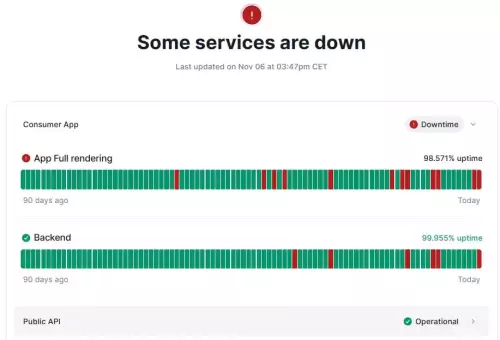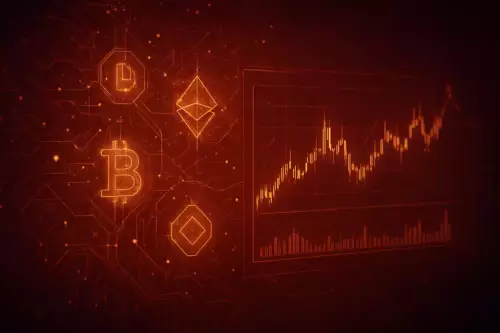 |
|
 |
|
 |
|
 |
|
 |
|
 |
|
 |
|
 |
|
 |
|
 |
|
 |
|
 |
|
 |
|
 |
|
 |
|
Cryptocurrency News Articles
Quantum Computing, Crypto, and Black Swans: Navigating the Impending Q-Day
Jun 30, 2025 at 07:02 am
Quantum computing's rapid advancements pose a significant threat to cryptocurrency. This blog explores the risks, potential solutions, and which coins might survive the 'Q-Day'.

Quantum computing's relentless march forward has sparked concerns across the crypto landscape. The potential for quantum computers to crack current cryptographic standards introduces a 'Black Swan' event, threatening the very foundation of digital assets. Let's dive into the quantum threat, assess the landscape, and see who might weather the storm.
The Quantum Sword of Damocles: 'Q-Day' Looms
The threat isn't science fiction anymore. Simulations, like those using OpenAI's ChatGPT o3 model, paint a sobering picture. A quantum breakthrough, potentially as early as 2026, could render today's cryptographic systems obsolete. This hypothetical 'Q-Day' poses an extinction-level risk to blockchains like Bitcoin and Ethereum.
At its core, blockchain security relies on asymmetric cryptography. Quantum computers, leveraging algorithms like Peter Shor’s, could potentially reverse-engineer private keys from public data, breaking the digital signatures that secure our wallets and transactions.
Bitcoin: A Fortress Under Siege?
Bitcoin, with its reliance on the Elliptic Curve Digital Signature Algorithm (ECDSA), is particularly vulnerable. A significant chunk of BTC remains locked in legacy wallets without quantum-resistant protections. Estimates suggest that a substantial portion of Bitcoin holdings could be compromised post-Q-Day.
Bitcoin's strength – its conservative development culture – could ironically become its weakness. The inability to adapt quickly might delay vital countermeasures, leaving it exposed in a crisis. As the o3 model puts it, Bitcoin’s survival isn’t cryptographic—it’s sociopolitical.
Ethereum: Agile, But Not Immune
Ethereum, while sharing Bitcoin’s ECDSA vulnerability, boasts a more adaptable ecosystem. Its active developer community and rapid upgrade history are key assets. Ethereum has demonstrated its capacity to coordinate complex transitions, offering hope for a swift response to the quantum threat.
However, the shift to post-quantum cryptography would require extensive infrastructure overhauls. Millions of smart contracts, including those in DeFi protocols, are vulnerable to quantum decryption. While some contracts can be upgraded, vast portions of Ethereum’s contract base may be impossible to rescue without chain-wide intervention.
The Quantum-Ready Few: Algorand and Beyond
Not all blockchains are created equal. Algorand emerges as a frontrunner in quantum resilience. Designed with future-proofing in mind, it incorporates cryptographic innovations like Verifiable Random Functions (VRFs) and has actively explored lattice-based encryption methods.
Polkadot also ranks high, with its parachain architecture allowing for independent blockchains to adopt their own quantum-resilient cryptography. Other well-positioned contenders include Cosmos, Avalanche, Harmony, Tezos, Radix and Hedera.
The Vulnerable: Privacy Coins and Meme Tokens
Privacy-focused cryptocurrencies face a particularly grim outlook. Quantum algorithms could dismantle their anonymity features, exposing past transactions. Meme coins and low-infrastructure tokens are also nearly defenseless, lacking the development teams and governance mechanisms needed to adapt.
A Call to Action: Preparing for the Inevitable
The message is clear: strategic risk awareness is paramount. Quantum computing is not a hypothetical threat; it's an inevitable one. The crypto industry must prioritize research, improve governance, abstract cryptography, and educate communities on quantum resilience.
So, while the quantum future might seem daunting, remember: even Black Swans can be navigated with foresight and preparation. Maybe it's time to dust off that old quantum physics textbook, or, you know, just HODL and hope for the best. Either way, buckle up – it's going to be an interesting ride!
Disclaimer:info@kdj.com
The information provided is not trading advice. kdj.com does not assume any responsibility for any investments made based on the information provided in this article. Cryptocurrencies are highly volatile and it is highly recommended that you invest with caution after thorough research!
If you believe that the content used on this website infringes your copyright, please contact us immediately (info@kdj.com) and we will delete it promptly.






























































